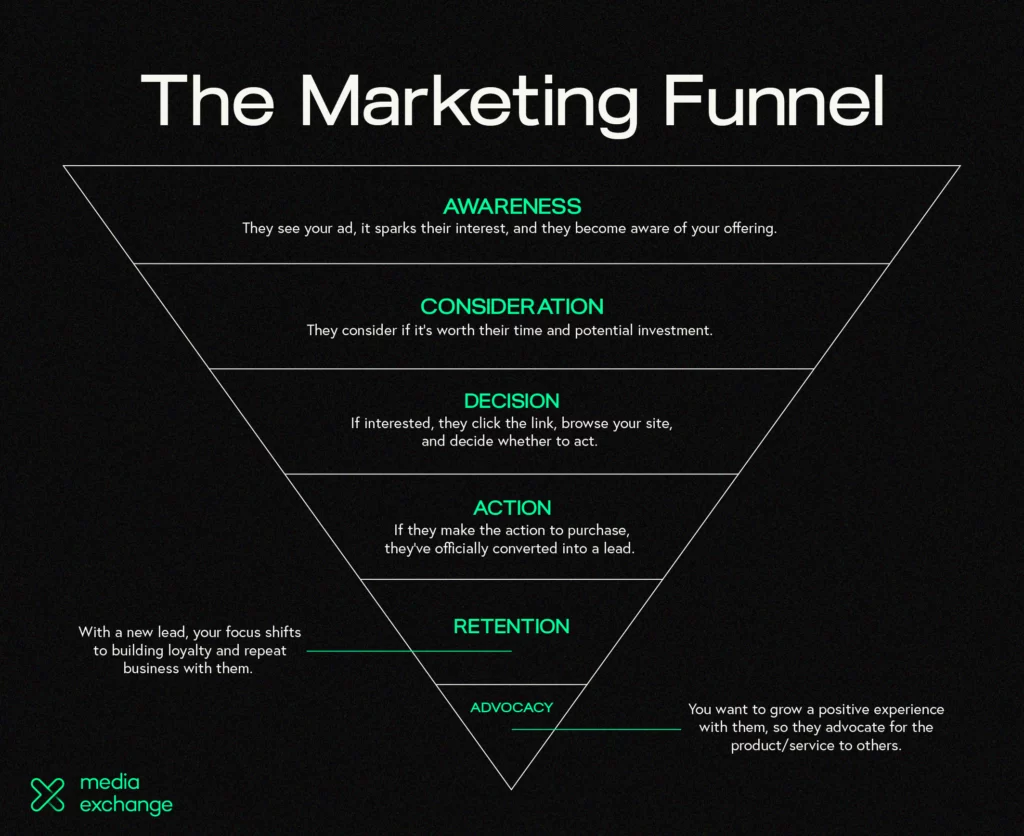Nothing kills an ad faster than a blurry image, unclear copy, and a message that leaves people wondering what’s even being sold. You’ll lose your audience in seconds.
Great ad design isn’t just about looking good; it’s how brands communicate and make an impact. You could have the best product and the perfect offer, but if your ad is visually unappealing, confusing, or just plain dull, it won’t get traction.
A well-designed Meta ad should grab attention instantly, clearly communicate who you are and what you’re offering and guide your audience toward taking action. In a world of endless scrolling, you have mere seconds to make an impression, so it’s critical you make it count.
The importance of meta ads
Meta ad designs are a key part of any online marketing strategy. They allow you to create, track, and optimise campaigns that reach the right audience. By leveraging data such as geographics, interests, behaviours, demographics, Meta ads help connect with the people most likely to engage with your business or brand.
Located on Facebook and Instagram, two of the biggest advertising platforms, Meta ads give businesses access to billions of users, where content can be shared in various formats in their news feed or through the story highlights feature. Meta ads can easily be tracked through real-time analytics and include performance-based ad campaign optimisation, which helps improve a business’ marketing strategy and tactics over time.
How to design effective meta ads
So what makes a good ad? How can you design it to make an impact? Let’s check it out.
1. Think about format
When beginning the design process, the first step is to think about the format. Having a clear understanding of it will help you to visualise your ad, what elements need to be included, and how to execute it. Pick from horizontal or vertical. Decide if it will be a short or long format Video, a carousel of multiple static images, or a single standout picture. Think about how it will look on a mobile device vs a website. Planning first will make the design process easier.
Say you are an e-commerce company, with a variety of products online. A video may work well for demonstrating how to use your product, while a carousel post may be a better choice for showcasing multiple products in one line. Or if you’re announcing a new product, a single standout image would give it its own spotlight. Sometimes you may run campaigns that share the same design in different formats, so knowing how to adjust it for multiple sizes is important too. The right format can drastically enhance your ad’s overall impact, engagement, and effectiveness.
2. Understand ad placement and optimise it
With a format picked, the most important aspect to consider next is: where will this ad be popping up? Will you be designing it for mobile or desktop? Will it go on the Facebook news feed? An Instagram story ad? Think about where your target audience is and the best ad placement to reach them.
Once you understand the ad’s purpose and placement, it’s time to move on to optimising the ad.
- Imagery: It’s recommended to use attention-grabbing, high-quality images that truly represent your brand. Make it very clear what you are advertising. Pick pictures from photoshoots to show your product or service in action. Size the images correctly to avoid wasted space or odd margins. If hiring a photographer for a shoot is too expensive or you don’t have content for your business, another option is to use free images from platforms such as Canva or Unsplash. While it won’t be as authentic, it’s still a great way to display visuals.
- Message: Have a clear message or story of what the ad is focused on. It’s been proven that ads that have an emotion-based element or relatable connection resonate more memorably with people. The better you understand your target audience—what they need and what speaks to them—the stronger your ad will be. When writing the message, make it short and snappy. Avoid overwhelming the viewer with too much text.
The combination of an effective image and a strong message will set you up for success.
3. Consider the impact of colour
It’s surprising how much influence colour can have. People subconsciously associate certain emotions and thoughts with specific colours, shaping how they perceive an ad. The right colours can make a Meta ad resonate deeply, while the wrong ones can send the wrong message entirely.
Think about it: contrasting colours grab attention, consistent branding keeps your business memorable, and certain colours even mess with people’s emotions (in a good way). Here’s a quick cheat sheet:
- Yellow = Optimism
- Orange = Friendly
- Red = Excitement
- Purple = Creativity
- Blue = Trust
- Green = Peace
- Gray = Balance
When choosing colours, consider your market—what they like, what they expect, and how colour influences their emotions.
Now, let’s put this into action. Imagine you’re making an ad for a dog adoption campaign. It’s an emotional, heartfelt cause, so using soft blues and grays sets the right tone. But swap those for bold reds and yellows? Suddenly it feels more like a discount sale at a pet store.
Colour isn’t just a design choice—it’s a strategy. Use it wisely, and your ads won’t just be seen; they’ll be felt.
4. Be strategic with location
When designing your Meta ad, think about the specific demographics or regions you’re trying to appeal to. Meta gives you the power to speak to particular audiences, so make sure to use it to your advantage.
If you’re running an ad in Sydney, think about how Sydney locals see themselves and what resonates with them. For example, Sydney locals pride themselves on being effortlessly stylish—activewear is everywhere, but they still appreciate good fashion. Tailor your ad to reflect this vibe.
Now, take Melbourne. Fashion here is often described as more ‘edgy’ or ‘individualistic’ compared to other cities. Locals mix high fashion with vintage and avant-garde looks, and they love expressing their unique style. This means the same ad likely won’t connect with both Sydney and Melbourne audiences in the same way.
Nailing the psychological message of an ad and then designing it to connect with viewers is how you make it truly resonate.
5. Have a value proposition and clear call to action
Put simply: make it crystal clear what you want users to do. You’ve got about one second to capture their attention—if it doesn’t grab them, they’ll swipe right past you.
Your ad should have a clear value proposition—think of it as your catchy tagline that sums up your message in just a few words. Then, in the caption or headline, hit viewers with a call to action (CTA) in a bold, noticeable font. Whether it’s “Sign up now,” “Shop today,” or “Learn more,” you need to give them a clear direction to take the next step. If they do, you’ve just guided them a step further down the marketing funnel.
The marketing funnel works like this:

You want to grow a positive experience with them, so they advocate for the product/service to others.
A great ad design — one that’s relatable and relevant — is what kickstarts this journey. But an ad that doesn’t hit the mark? They’ll keep scrolling.
Obviously you want customers to go through all 6 steps, but it starts with their awareness. Thankfully, if your ad captures attention and gets viewers to click, you’re already 20% of the way there.
When designing an ad, its style and look must align with your brand guidelines. The message and tone also need to match what’s on the website. The link should be to your official site or a shopping site you run to build credibility with users. This is anything from common elements of the same colours, fonts, and images. Consistency is everything because ads are similar to a promise to the viewer. If your ad feels one way and your website feels completely different, it creates a disconnect. This inconsistency can confuse users and make them bounce.
Now it’s time to bring your ad to life. With these five steps in place, you’re ready to design it to make an impact and grow your business.
Test! Test! Test!
Test multiple variables such as different copy, design layouts, or value propositions, to see which version of your ad brings in the most amount of clicks and conversions. It’s like tasting different flavours of ice cream before knowing which one you want to buy. The same methodology can be applied to Meta ads through A/B testing, a method that helps you understand what visually and psychologically resonates with viewers—and what doesn’t.
A/B testing lets you compare duplicate ad campaigns with either different ad copy or offers and with different images to Test and see which one performs better. You can also compare different audiences, ad placements, and ad creatives (like Static Image vs Video). Once it’s all set up and ad impressions are served to people, the test will run and you can see which ads or audiences performed better. By using this approach, you can refine your Meta Ad strategy and identify areas for improvement to boost your conversion rates moving forward.
Time for you to take action
Meta ads can be quite effective and make a massive difference if designed correctly. Then when mixed with persuasive copy (more on that in Part 2!), a smart advertising strategy and a good team behind it, you have all the potential to bring in heaps of new leads to your business. The 5 tips above are here to help you thrive and take your business to that next level.
If you’re looking for support in starting a Meta ad campaign, don’t worry! Our team here at Media Exchange is skilled in Meta ad strategy, including; designing compelling ads, ad campaign set up, ad deployment to the right audiences, and ongoing ad management. We can guide you from start to finish, working to drive results.
If you’d like to connect, exchange details with us here.

